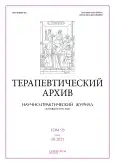Prognostic factors for the carbohydrate metabolism normalization in patients with type 2 diabetes mellitus and obesity using liraglutide 3.0 mg per day
- Authors: Sklyanik I.A.1, Shestakova M.V.1
-
Affiliations:
- Endocrinology Research Centre
- Issue: Vol 93, No 10 (2021)
- Pages: 1203-1208
- Section: Original articles
- URL: https://journals.rcsi.science/0040-3660/article/view/86963
- DOI: https://doi.org/10.26442/00403660.2021.10.201070
- ID: 86963
Cite item
Full Text
Abstract
Background. Glucagon-like peptide-1 receptor agonists (GLP-1 RA) are innovative drugs that effectively reduce glycemic levels and overweight in patients with type 2 diabetes mellitus (T2DM). However, the criteria for predicting the hypoglycemic effect of this group of drugs have not been practically defined.
Aim. To assess the factors contributing to the achievement the glycemia normalization in patients with diabetes mellitus and obesity by adding to antihyperglycemic therapy (AT) a drug from the GLP-1 RA group – liraglutide 3.0 mg per day.
Materials and methods. A single-center, prospective, non-randomized study was provided. The objects of the study were patients with T2DM and obesity (n=22). Liraglutide 3.0 mg per day was added to the current AT of patients. Initially, the parameters of carbohydrate metabolism, hormones of the incretin system on an empty stomach and during the mixed-meal test, insulin resistance using the euglycemic hyperinsulinemic clamp test, and body composition were studied. After 9 months of therapy, all studies were repeated and a search for possible predictors of the carbohydrate metabolism normalization was made.
Results. The body mass index of patients decreased from 42.4 [37.7; 45.0] to 35.9 [33.0; 40.9] kg/m2. Fasting blood glucose and glycated hemoglobin levels decreased from 9.02 [7.40; 11.37] mmol/L and 7.85 [7.43; 8.65]% up to 5.90 [5.12; 6.18] mmol/L and 6.40 [5.90; 6.60]%, respectively. 14 (63.6%) patients reached normoglycemia. Insulin resistance according to the clamp test did not change over the study. Basal concentrations of oxyntomodulin, glycentin and the area under the GLP-1, oxyntomodulin, glycentin curve significantly decreased 9 months after liraglutide administration. The prognostic marker of the achievement of normoglycemia during therapy with liraglutide 3.0 mg/day is the level of endogenous GLP-1>5.5 pmol/L before the appointment of arGPP-1 therapy.
Conclusion. The concentration of endogenous GLP-1 before the appointment of liraglutide therapy at a dose of 3.0 mg per day can be used for prediction the drug hypoglycemic effect and achieving normoglycemia possibility.
Full Text
##article.viewOnOriginalSite##About the authors
Igor A. Sklyanik
Endocrinology Research Centre
Author for correspondence.
Email: sklyanik.igor@gmail.com
ORCID iD: 0000-0002-7768-4717
науч. сотр.
Russian Federation, MoscowMarina V. Shestakova
Endocrinology Research Centre
Email: sklyanik.igor@gmail.com
ORCID iD: 0000-0002-5057-127X
акад. РАН, д-р мед. наук, проф., зав. каф. диабетологии и диетологии, дир. Института диабета, зам. дир.
Russian Federation, MoscowReferences
- Дедов И.И., Шестакова М.В., Викулова О.К., и др. Эпидемиологические характеристики сахарного диабета в Российской Федерации: клинико-статистический анализ по данным регистра сахарного диабета на 01.01.2021. Сахарный диабет. 2021;24(3):204-21 [Dedov II, Shestakova MV, Vikulova OK, et al. Epidemiological characteristics of diabetes mellitus in the Russian Federation: clinical and statistical analysis according to the diabetes register data as of 01.01.2021. Diabetes mellitus. 2021;24(3):204-21 (in Russian)]. doi: 10.14341/DM12759
- Дедов И.И., Шестакова М.В., Майоров А.Ю., и др. Сахарный диабет 2 типа у взрослых. Сахарный диабет. 2020;23(2S):4-102 [Dedov II, Shestakova MV, Mayorov AY, et al. Diabetes mellitus type 2 in adults. Diabetes Mellitus. 2020;23(2S):4-102 (in Russian)]. doi: 10.14341/DM12507
- American Diabetes Association. 9. Pharmacologic Approaches to Glycemic Treatment: Standards of Medical Care in Diabetes – 2021. Diabetes Care. 2021;44(Suppl. 1):S111-24. Available at: http://care.diabetesjournals.org/lookup/doi/10.2337/dc21-S009. Accessed: 17.09.2021
- Mannino GC, Andreozzi F, Sesti G. Pharmacogenetics of type 2 diabetes mellitus, the route toward tailored medicine. Diabetes Metab Res Rev. 2019;35(3):e3109. doi: 10.1002/dmrr.3109
- DeFronzo RA, Tobin JD, Andres R. Glucose clamp technique: a method for quantifying insulin secretion and resistance. Am J Physiol. 1979;237(3):E214-223. Available at: http://www.ncbi.nlm.nih.gov/pubmed/382871. Accessed: 17.09.2021.
- Шестакова Е.А., Скляник И.А., Паневина А.С., Шестакова М.В. С чем связано отсутствие нарушений углеводного обмена у лиц с длительным анамнезом ожирения – с низкой инсулинорезистентностью или сохранной секрецией инсулина? Вестник Российской академии медицинских наук. 2018;73(5):344-53 [Shestakova EA, Sklyanik IA, Panevina AS, Shestakova MV. Is absence of carbohydrate metabolism disorders in patients with prolonged history of obesity due to low insulin resistance or preserved insulin secretion? Annals of the Russian Academy of Medical Science. 2018;73(5):344-53 (in Russian)]. doi: 10.15690/vramn1027
- Kesavadev J, Shankar A, Thacker H, et al. Treatment outcomes with liraglutide in new onset type 2 diabetes – a retrospective analysis. Endocr Pract. 2017;23(Suppl. 3):50-1.
- Mensberg P, Nyby S, Jørgensen PG, et al. Near-normalization of glycaemic control with glucagon-like peptide-1 receptor agonist treatment combined with exercise in patients with type 2 diabetes. Diabetes Obes Metab. 2017;19(2):172-80. doi: 10.1111/dom.12797
- Jinnouchi H, Sugiyama S, Yoshida A, et al. Liraglutide, a Glucagon-Like Peptide-1 Analog, Increased Insulin Sensitivity Assessed by Hyperinsulinemic-Euglycemic Clamp Examination in Patients with Uncontrolled Type 2 Diabetes Mellitus. J Diabetes Res. 2015;2015:1-8. Available at: http://www.hindawi.com/journals/jdr/2015/706416/ Accesed: 17.09.2021.
- Kim SH, Abbasi F, Nachmanoff C, et al. Effect of the glucagon‐like peptide‐1 analogue liraglutide versus placebo treatment on circulating proglucagon‐derived peptides that mediate improvements in body weight, insulin secretion and action: A randomized controlled trial. Diabetes Obes Metab. 2021;23(2):489-98. doi: 10.1111/dom.14242
Supplementary files








